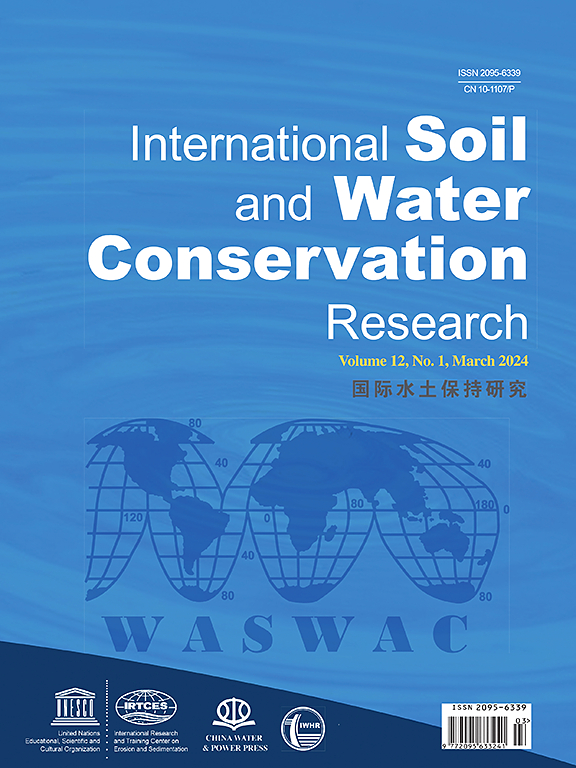半干旱流域事件尺度径流产沙模拟
IF 7.3
1区 农林科学
Q1 ENVIRONMENTAL SCIENCES
International Soil and Water Conservation Research
Pub Date : 2025-07-04
DOI:10.1016/j.iswcr.2025.07.001
引用次数: 0
摘要
K2-RHEM是最近集成的基于事件的牧场流域模型,是少数几个基于过程的牧场应用模型之一。然而,为了获得更广泛的接受和证明其可靠性,综合评价结果是必不可少的。在本研究中,对美国农业部- ars核桃沟实验流域内5个小型半干旱流域的K2-RHEM进行了评估。利用广泛的径流和泥沙数据,以及对河道头部、土壤质地和河道横截面的实地调查,该模型在预测水文指标方面表现出强大的性能,无需校准:径流的NS范围为0.53至0.87,KGE范围为0.54至0.88;径流峰值NS为0.59 ~ 0.85,KGE为0.69 ~ 0.90;峰值时间NS为0.98 ~ 0.99,KGE为0.94 ~ 0.98。产沙量预测在河道切口较大的流域尤其准确,NS为0.65,KGE为0.79。3个流域的产沙量校准和验证结果均较好,最小流域的产沙量校准和验证结果较为合理。产沙量和径流峰值对流域离散化程度敏感。即使在小流域,增加雨量计也能改善模型的性能。这些发现证明了K2-RHEM作为小规模牧场流域管理中水文和侵蚀预测的可靠工具的潜力,并强调了在模型应用中适当的流域离散化和降雨数据分辨率的重要性。本文章由计算机程序翻译,如有差异,请以英文原文为准。
Modeling runoff and sediment yield at the event scale in semiarid watersheds
K2-RHEM, a recently integrated event-based rangeland watershed model, represents one of the few process-based models available for rangeland applications. However, to gain wider acceptance and demonstrate its reliability, comprehensive evaluation results are essential. In this study, K2-RHEM was evaluated in five small semi-arid watersheds within the USDA-ARS Walnut Gulch Experimental Watershed. Using extensive runoff and sediment data, along with field surveys on channel heads, soil textures, and channel cross-sections, the model showed strong performance in predicting hydrology metrics without calibration: NS ranged from 0.53 to 0.87 and KGE from 0.54 to 0.88 for runoff; NS from 0.59 to 0.85 and KGE from 0.69 to 0.90 for runoff peak; and NS from 0.98 to 0.99 and KGE from 0.94 to 0.98 for time to peak. Sediment yield predictions were particularly accurate in watersheds with significant channel incisions, with NS of 0.65 and KGE of 0.79. Good sediment yield calibration and validation results were achieved in three watersheds, and reasonable results achieved in the smallest watershed. Sediment yield and runoff peak were found to be sensitive to level of watershed discretization. Improved model performance was seen with additional rain gauges even in small watersheds. These findings demonstrate the potential of K2-RHEM as a reliable tool for the prediction of hydrology and erosion for small-scale rangeland watershed management and highlight the importance of both proper watershed discretization and rainfall data resolution in model applications.
求助全文
通过发布文献求助,成功后即可免费获取论文全文。
去求助
来源期刊

International Soil and Water Conservation Research
Agricultural and Biological Sciences-Agronomy and Crop Science
CiteScore
12.00
自引率
3.10%
发文量
171
审稿时长
49 days
期刊介绍:
The International Soil and Water Conservation Research (ISWCR), the official journal of World Association of Soil and Water Conservation (WASWAC) http://www.waswac.org, is a multidisciplinary journal of soil and water conservation research, practice, policy, and perspectives. It aims to disseminate new knowledge and promote the practice of soil and water conservation.
The scope of International Soil and Water Conservation Research includes research, strategies, and technologies for prediction, prevention, and protection of soil and water resources. It deals with identification, characterization, and modeling; dynamic monitoring and evaluation; assessment and management of conservation practice and creation and implementation of quality standards.
Examples of appropriate topical areas include (but are not limited to):
• Conservation models, tools, and technologies
• Conservation agricultural
• Soil health resources, indicators, assessment, and management
• Land degradation
• Sustainable development
• Soil erosion and its control
• Soil erosion processes
• Water resources assessment and management
• Watershed management
• Soil erosion models
• Literature review on topics related soil and water conservation research
 求助内容:
求助内容: 应助结果提醒方式:
应助结果提醒方式:


